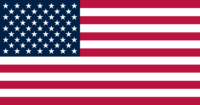United States of America
| United States
United States of America | |

Flag | |
| omit
Location of the United States | |
| Capital | Washington, D.C.
38°53′N 77°01′W |
| Official language(s) | None (de jure) |
| Recognized Languages | English
Spanish |
| Ethnic groups | 61.6% White
12.4% Black 6.0% Asian 1.1% Native American 0.2% Pacific Islander 10.2% Multiracial 8.4% Others |
| Religion | 63% Christianity
40% Protestantism 21% Catholicism 2% Other Christian 29% No religion 6% Others 2% Unanswered |
| Demonym(s) | American |
| History | Independence from Great Britain |
The United States of America, colloquially known as the United States, US, or, colloquially since the mid-twenty-eighties, the East Coast Federation or simply the East Coast, is a country located in North America. Although its territorial claims extend to the entirety of the central part of the continent, from the Atlantic to the Pacific oceans, the country realistically only projects power over the North American eastern coast, roughly stretching from Florida in the South to Lake Ontario in the North, with its northeastern border cutting through the old states of New York, Pennsylvania and New Jersey, while bound in the West and North by the Mississippi and Ohio rivers. It covers a land area of nearly 1.380 million square kilometres or 532,800 square miles and is divided into thirteen federal states, one capital district and four free cities enjoying various degrees of autonomy dotted along the coast of New England. There officially exists a fourth free city encompassing the whole Long Island, but control over the region has been partial at best. The country counts a population of approximately 230 million inhabitants. The national capital is Washington, D.C. and the most populous city of the contiguous United States (excluding the free cities) is Philadelphia.
Initially inhabited by various Native American tribes, the territory of the United States was colonised by European powers starting in the sixteenth century. The United States emerged from the Thirteen Colonies established by Great Britain along the East Coast and quickly grew westwards over the territory of other colonial powers such as France and Spain and that of native tribes. The Spanish-American War of 1898 and the First World War in 1917 and 1918 established the United States as a great power on the world stage, a position further confirmed by the outcome of the Second World War in 1943 along with Japan, France, and the United Kingdom. The world enjoyed a period of unprecedented peace for the following decade or two before tensions arose between the Japan-US led Trans-Pacific Treaty Organisation and the Europe-centered Pan-European Entente over the question of imperialism and the growing restlessness in colonies across the globe. The Cold War saw the two blocs engage in a series of proxy-wars, respectively funding and combatting separatist and independentist groups, culminating in the Third World War in 2028 and the nuclear bombing of Paris. Relations were progressively normalised after a mutually-agreed ceasefire while the political decolonisation of Africa began.
As the power of corporations across the Earth grew, so did unrest in the United States. With attention taken off the now finished Cold War with Europe, the American public was able to turn their eyes to their own affairs: the 2050's and 2060's saw a growing distrust of corporation among the population which led to the landslide victory of President José Sepùlveda in 2072, his drastic, anti-corporate agenda, the immediate attempt at his impeachment upon the first threat he posed to the interests of companies, his eventual removal from office and replacement with an unelected, corporate-backed candidate. To most, it seemed as if the nation had burst overnight, but the previous two decades had been the witness of growing polarisation in the federal and local governments. The Second American Civil War began soon after Sepùlveda's removal, the day after news of his imprisonment were broadcasted across the country. The war lasted until 2079 with the corporate-backed government winning hegemony over most of the eastern part of the country under the dominance of the CoreLink conglomerate, though skirmishes over the border to the north-east and across the Ohio and Mississippi rivers to the north and west still occur to this day. Several cities across formerly American territory still claim allegiance to the Washington-government, while the rest of the country has splintered into various squabbling states, from internationally recognised, stable new nations to disorderly, mysterious, unrecognised countries hastily propped up by small groups in the center of the former country, to reestablished native-american nations. The territory is fragmented and wild at times, with safe havens bordering war zones at every turn of the road.
Contents
The East Coast Federation
History
World War II (1938-1943)
Post-War Era (1944-1966)
Cold War Era (1967-2027)
World War III (2028)
Decolonisation (2029-2050)
Internal Strife (2051-2074)
Second Civil War (2075-2079)
Fragmentation (2080- )
Geography
geography
Politics
politics
Culture & Demographics
demographics